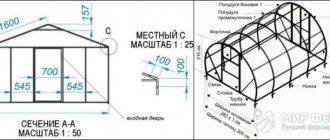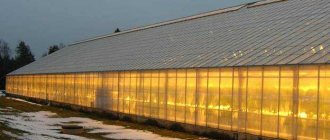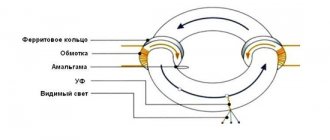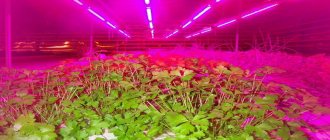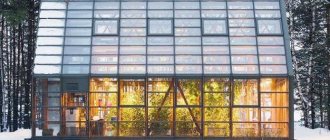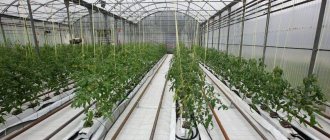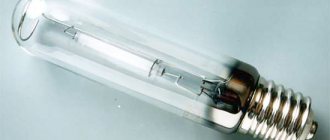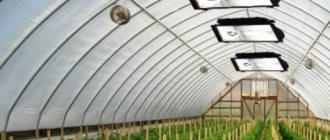Lighting systems are installed in greenhouses for year-round or winter use when growing light-loving vegetables, berries, seedlings and flowers - without lighting, these crops will not produce a good harvest. Modern greenhouse lighting systems are increasingly using LEDs: they are economical, durable and allow you to adjust the spectrum and illumination over a wide range.
LED lighting for greenhouses
Portable LED luminaire for vertical installation
A special feature of LEDs is that their luminous flux is directed predominantly in one direction.
Features of LED lamps
LED lamps provide plants with the light they need for their development, which is converted into waves of different lengths. Thus, the flora of greenhouses absorbs only the spectrum of radiation that it needs most.
In addition, the radiation of the lamps is as close as possible to natural sunlight. Their spectrum includes only waves useful for plant growth.
The list of significant benefits also includes:
- Stability of the specified lighting for the required time.
- The efficiency of LEDs exceeds 80%.
- The spectrum does not contain ultraviolet and infrared waves.
- High environmental performance.
- Lighting greenhouse plants only with waves of a certain spectrum.
- Relatively low energy consumption compared to other types of lighting.
The only disadvantage of using LED lamps in greenhouses is its relatively high cost. Not every farmer is ready to pay from $200 to $1,500 for lighting (depending on the area of the room).
Comparative economic analysis
When calculating the economic efficiency of using LED installations, one should take into account not only the prices of lamps and energy savings due to the reduced energy consumption of LEDs. The calculation must include the cost of generation (in particular, the cost of a gas turbine unit). This is true because LED installations consume significantly less power and, accordingly, the power of electric generators is also required significantly less. Taking this fact into account leads to significant cost savings when deploying greenhouses from scratch.
Let's conduct a comparative economic analysis of four lighting installations using the following example. Initial parameters:
- The total estimated area is 20 hectares. The size of standard sections is 6.4 m × 81 m (518.4 m2).
- Producing electrical and thermal energy using a gas turbine unit. The price of an installation with a capacity of 5 to 15 MW is 50,000 rubles/kW, with a capacity of 20–30 MW—40,000 rubles/kW. The cost of 1 kW of electricity is 1.5 rubles.
- 1st installation: based on luminaires with electronic ballast ZhSP 64-600-002R/380 V with DNaZ super/Reflux S 600/400 V lamps. Serviced area by one luminaire 4.9 m2, power consumption 630 W, wide KSS, level FFP of the new lamp is 1120 µmol/s (228 µmol/m2×s), efficiency 1.77 µmol/J, price 7774 rubles. (including the price of the lamp is 1809 rubles)
- 2nd installation: based on LED lamps EL-008M-240 from ENOVA Light LLC. The area served by one lamp is 4.9 m2, power consumption is 240 W, wide CSS, FPP level is 720 µmol/s (145 µmol/m2×s), efficiency is 3.0 µmol/J, price is 18,000 rubles.
- 3rd installation: based on LED lamps EL-008M-180 from ENOVA Light LLC. The area served by one lamp is 4.9 m2, power consumption is 180 W, wide CSS, FPP level is 540 µmol/s (110 µmol/m2×s), efficiency is 3.0 µmol/J, price is 13,500 rubles.
The results of the analysis are shown in Table 2. Table 2. Comparative analysis of lighting installations*
| № | Parameter name | 1st NLVD installation (228 µmol/m2×sec) | 2nd LED installation (145 µmol/m2×sec) | 3rd LED installation (110 µmol/m2×sec) |
| 1 | Number of lamps, pcs. | 40816 | ||
| 2 | Total power consumption, kW | 25714 | 9796 | 7347 |
| 3 | Power/price of thermal power plants, MW/million rubles. | 31/1240 | 11/550 | 9/450 |
| 4 | Total price of lamps, million rubles. | 317.3 | 734.7 | 551 |
| 5 | Price of the lighting system (luminaires + thermal power plant), million rubles. | 1557.3 | 1284.7 | 1001 |
| 6 | Cost reduction compared to the first installation, RUB million. | — | 272.6 (by 17.5%) | 556.3 (by 35.7%) |
| Reduced energy costs during operation | ||||
| 7 | Total consumption with a duration of additional lighting of 5000 hours per year (13.7 hours per day) (MWh)/price (million rubles) | 128570/192.9 | 48980/73.8 | 36735/55.1 |
| 8 | Total consumption with a duration of additional lighting of 6935 hours per year (19.0 hours per day) (MWh)/price (million rubles) | 178327/267.5 | 67935/101.9 | 50951/76.4 |
| 9 | Total consumption with a duration of additional lighting of 7300 hours per year (20.0 hours per day) (MWh)/price (million rubles) | 187712/281.6 | 71511/107.3 | 53633/80.5 |
| 10 | Cost reduction compared to the first installation with additional lighting duration of 5000/6935/7300 hours per year (RUB million) | — | 119.1/165.6/174.3 | 137.8/191.1/201.1 |
| 11 | Cost reduction over 2 years compared to the first installation with additional lighting duration of 5000/6935/7300 hours per year, million rubles. | — | 238.2/331.2/348.6 | 275.6/382.2/402.2 |
| 12 | Cost reduction over 3 years compared to the first installation with additional lighting duration of 5000/6935/7300 hours per year, million rubles. | — | 357.3/496.8/522.9 | 413.4/573.3/603.3 |
| 13 | Price of lamps for group replacement of lamps, million rubles. | 73.8, after 10,000 operating hours | — | — |
*Explanations for table No. 2:
- line 1 indicates the number of lamps required to cover 20 hectares of greenhouses;
- line 2 indicates the total power consumption of the luminaires indicated in line 1;
- line 3 indicates the required power of the electrical installation and its price;
- line 4 indicates the price of the lamps indicated in line 1;
- line 5 indicates the total price of all lamps and electrical installations (page 4+page 3);
- line 6 indicates how much cheaper an LED installation is than an NLVD installation;
- lines 7-9 contain information on the consumption of installations at different durations of additional lighting and price per year;
- Rows 10-12 contain information about cost savings from LED adoption over 1, 2, and 3 years, respectively.
Types of LED lighting
Manufacturers classify several types of LED devices, from which the consumer can choose the one that will correspond to the number of shelves in the greenhouse and the type of plants. The following lighting devices are distinguished:
- Single lamps - lighting of this form is used for growing a small number of seedlings.
- Pipes are an indispensable device if narrow and long shelving is placed in the greenhouse.
- Floodlights are devices that can illuminate plants that occupy a large area and from a greater distance.
- Tablets - square shapes of the lamp allow you to provide professional lighting for wide format shelving.
- Tapes are lighting fixtures that can be placed in any order. Often, this type of lighting equipment is made by hand.
Light and its importance for plants
With a lack of daylight in winter and autumn, crops begin to wither and become sick. The key to the survival and healthy existence of plants is photosynthesis. Full photosynthesis is impossible without light. When plants produce chlorophyll, they fully absorb the carbon dioxide needed for nutrition. The formation of organic substances in greenhouse crops is impossible without solar and artificial lighting.
Signs of lack of lighting:
- changes in plant shape (for example, unnatural elongation of cuttings and stems);
- their slow growth;
- lack of flowering;
- drop in yield;
- the lower foliage turns yellow.
You may be interested in: DIY lighting for seedlings Not a single living organism is capable of existing without light. Plants, especially in the initial stages, need...Read more...
Calculation of LED greenhouse lighting
To calculate the required number of LED lamps, it is necessary to take into account their luminous flux, as well as the distance between the lighting device and the plants.
If you want to calculate the luminous flux required for a plant whose development occurs in diffused light, you need to take 3000 lux per square meter. m.
As a result, if a lamp has an illumination of 500 lm and you need to calculate per 1 sq. m of lighting at a distance from the device to the plant of 30 cm, according to the formula derived in practice:
Network flux = illumination/distance * value of required lamp illumination per 1 sq. m.
In our example, the illumination will be 500/(0.3*0.3) = 5555 lux.
- 500 - lamp illumination;
- 0.3 – distance given in SI system;
- 0.3 – the value of the required illumination per square meter. m., converted to the SI system.
Considering that the losses at a given distance from the device to the plant are 30%, we get an approximate value of 3890 lux. It turns out that for plants that love diffused light, 1 lamp with a power of 10 W per square meter is enough. m.
For the development of inflorescences and flowers of greenhouse plants, illumination should be maintained at a value of at least 5000 lux per square meter. m.
LED lamps for greenhouses
LED lamps are not afraid of water, so you don’t have to worry if, in case of watering, liquid gets on their surface. Such devices do not overheat, which makes it possible not to worry about increasing the temperature necessary for vegetation.
Rays in the blue and red spectrum converted by LED devices help accelerate the development of seedlings, budding, flowering and fruiting. The wavelength can practically reach the root system of the plant.
Manufacturers make all lamps of this type for different types of bases, and the carefully thought-out coating of the devices prevents the development of corrosion.
LED lamps can be purchased separately by installing a special mounting system for them, or you can buy a ready-made strip for this.
All lighting devices are presented on the market in two types:
- Permanent.
- Photoperiodic.
The latter are used for round-the-clock lighting of greenhouses, and the former are used to extend daylight hours, that is, for a certain number of hours. Their choice depends on the type of product grown.
In order for LED lamps to serve the consumer for many years, experts recommend using only products from branded manufacturers. For example, Philips, Siemens, Legrand, Osram, etc. Since LEDs come in different color spectrums, they can be combined to achieve certain tasks. By using lamps that emit different wavelengths, the yield can be significantly increased.
Application in crop production
The use of additional lighting in greenhouses will not be superfluous when growing cucumbers and tomatoes, onions, peppers, flowers and other plants. You can do without it, but the results will be worse. Below are rules and recommendations to keep in mind when growing various crops.
Cucumbers:
- Additional lighting is recommended;
- lighting should have a blue spectrum, during the period of flowering and formation of ovaries - red;
- natural lighting should smoothly transition into artificial lighting without gaps, this can be provided by relay greenhouse equipment;
- the culture needs 12 hours of light per day (natural + artificial lighting);
- The greenhouse should be dark for 1/4 of the day;
- When using artificial lighting, the temperature should be controlled within +8°C.
Tomatoes:
- Additional lighting is recommended after seedlings emerge;
- at first after germination of seedlings, 20 hours of light per day are needed, the duration gradually decreases to 12 hours;
- tomatoes need directional rather than diffuse lighting;
- It is contraindicated to illuminate the greenhouse around the clock, as this is fraught with the development of diseases.
Did you know? LED lamps have an efficiency of over 93% and have the highest light output
-
up to 100 Lm/W, while the indicator for fluorescent lamps does not reach 75 Lm/W.
Strawberry:
- When breeding, fluorescent lamps (length 1 m, power 40–50 W) have proven themselves well. Such a device is sufficient for normal additional lighting of an area of 4–6 m².
- It is necessary to periodically change the location of containers with seedlings.
- for 13–14 hours, warm spectrum lighting with an average brightness of 140 lux is required.
Onion. Experts say that natural light is sufficient for growing onions, but the greens will have a pale appearance. Phytolamps, as an additional light source, will help to cope with this problem: the greenery will become more elastic and the color will be brighter.
Strawberry . Although short daylight hours have a beneficial effect on the formation of strawberry buds, during the formation of inflorescences the plant needs illumination for 13–17 hours a day. In nature, such conditions are possible no earlier than mid-spring, so in May the strawberries are already blooming, and in June you can already enjoy the berries. By using additional lighting in the greenhouse, delicious strawberries can be tasted earlier, and the abundance of the harvest will pleasantly surprise you.
LED strip for greenhouse
An LED strip is a flexible printed circuit board on which LEDs are located at equal distances. Manufacturers produce it in rolls, the length of which is often 5 meters or more. The ease of mounting this type of lighting allows you to grow fruit-bearing plants not only in greenhouses, but also on windowsills and hotbeds. The tape can also be used as additional lighting, because it is quite energy-saving.
In this case, the combination of LEDs is presented in various configurations 15:5, 10:3, etc., depending on the purpose of lighting. The most popular is 5:1. This means that after every 5 red diodes there will be 1 blue one. During photosynthesis, the former are needed for the accumulation of carbohydrates, the latter contribute to the formation of amino acids, which is the main condition for cell division.
Our hands are not for boredom
Shouldn't we, as plant growers, take a chance on an LED lamp with our own hands and make it ourselves? Still, the price of lamps is high and not everyone can afford to buy them. LEDs for greenhouses can be purchased retail in stores or online. If you have some experience with a soldering iron, you can make such a lamp yourself.
Required tools:
- Multimeter
- Soldering iron
- Flux
- Solder
- Thermal Conductive Adhesive
- Thermal tape
Materials:
- Red LEDs 5 pieces FRM-R1
- Blue LEDs 5 pieces FRM-B1
- Driver RLD10
- Aluminum radiator
- MGTF wire (or other suitable one)
Radiator
What can serve as a radiator? Aluminum, copper, brass and even iron plates. In a word, everything that removes heat well. One LED requires approximately 25 cm2.
The radiator consists of three plates. The central plate has 5 holes: two for fastening the side plates and one central one for fastening the lamp itself.
During operation of the lamp, the radiator temperature should not exceed 50°C.
If the LED operates at temperatures above 50°C, it will quickly fail.
Light-emitting diode
LEDs come in different designs. The lamp requires LEDs with a power of 1 or 3 watts.
Blue LEDs are glued to the plate with conductive adhesive. Red LEDs are glued through thermally conductive tape to isolate the substrate from the wafer.
Before soldering or gluing the LEDs to the plate, be sure to ensure their polarity. A minus is pressed out on one of the LED terminal legs - this is the cathode. Accordingly, the other is the anode. That's a plus.
The photo shows that the LEDs are assembled in series. After assembling the entire chain, the RLD10 driver is connected to it.
The driver must be selected according to the future power of the lamp. The power of the lamp is equal to the sum of the powers of the LEDs.
The luminaire driver is capable of powering LEDs with a total power of 15 watts at a current of 330 mA. Thus, it can easily withstand a load of 10 LEDs.
LED floodlights for greenhouses
LED spotlights can be used in a greenhouse as primary and secondary lighting. Its main task is no different from the goals of other lighting devices - the wave spectrum should contribute to the enrichment of plants during flowering, as well as the growing season. An important advantage of this device is increased tightness, which plays a role in greenhouses where there is high humidity.
You can include any of the following waves in the spotlight spectrum:
- Blue – accelerates plant growth. Its length is 430, 460 nm.
- Red – has a positive effect on the processes of plant growth and flowering. Length – 630. 660 nm.
- Ultraviolet - promotes plant growth and destroys harmful insects. However, UV waves, whose length is 380 nm, are harmful to human health, so they are not included in the standard modification. But if the consumer wishes, manufacturers can add ultraviolet spectrum to the assembly.
- Infrared - accelerates plant growth, but has a negative effect on human health. Therefore, this spectrum, like UV waves, is not included in the standard assembly. However, if desired, nothing is impossible. Customer-conscious LED manufacturers can add IR waves to the modification.
Norms and requirements
It should be noted that all representatives of the plant world react differently to the effects of light radiation. Also, the radiation spectrum will stimulate different functions in growing crops, so you need to consider the length of the emitted waves, which lie in the ultraviolet or infrared spectrum:
- The ultraviolet spectrum from 300 to 400 nm is useful for removing harmful microorganisms from the greenhouse, but can be used exclusively for preventive purposes. Long-term exposure will be detrimental to the flora.
- Violet 400 - 430 nm - allows you to strengthen the trunk and increase resistance to external weather factors.
- Blue spectrum 440 – 460 nm – promotes the growth of both the root system and leaves, increases photosynthesis of crops grown in a greenhouse.
- Green 500 - 600 nm - has no practical benefit for the inhabitants of the greenhouse; if you install only such models of lighting devices, the entire crop may die.
- Yellow 600 – 620 nm – stimulates the elongation of plants, which is not suitable for all crops, for example, it is relevant for ornamental trees, shrubs and others. But it is useless for fruiting or flowering plants.
- Red spectrum 620 - 700 nm - under its influence, the production of carbohydrates and their further transportation are stimulated, which leads to the rapid development of fruits or peduncles.
- Infrared radiation of 780 nm or more leads to an increase in plant temperature, which can destroy the crop in the greenhouse.
The choice of a specific spectrum of lamps for artificial lighting is made in accordance with the variety of flora being grown and the desired result. In practice, lighting lamps can contain several spectra at once, which expands their functionality. But this does not apply to all lighting devices, so it is necessary to carefully study the features of the influence of lighting devices on the microclimate of the greenhouse and the condition of its inhabitants.
The influence of light on crops
Infrared lighting for winter greenhouses
Infrared lamps are also in demand among farmers engaged in agricultural activities. Moreover, their operating principle is quite similar to the significance of conventional incandescent lamps. The structure of this lighting device is a flask, the glass of which is often red in color. This characteristic increases the efficiency of infrared lamps. When waves pass through colored glass, the remaining visible light is reduced to a minimum.
Infrared lighting devices are in high demand due to the ability to create ideal conditions for the growth and development of plants and heat the room.
Consumers mainly use lamps in greenhouses whose characteristics meet the following requirements:
- Temperatures do not exceed 600 0C.
- The maximum power fluctuates at 250 W.
- The spectrum of IR waves is in the range of 3.5-5 microns.
To correctly calculate the number of such lamps per square meter. m. It is rational to take into account the height of their suspension. Neglecting this indicator can lead to climatic imbalance, which will adversely affect greenhouse plants.
What is best to use for greenhouse lighting?
All types of greenhouses will benefit from LED lights. They are suitable for both industrial greenhouses and greenhouses and winter gardens.
LED heaters can be used to increase crop yields.
Its light beam plays an important role when choosing. Belonging to one spectrum or another is determined by the wavelength. In addition to the red and blue diodes described above, orange, yellow, green and blue diodes can also be included in the modification of lighting fixtures.
When choosing lamps for greenhouses, it is important to pay attention to the lighting angle. There are three of them:
- Angle 600.
- Angle 900.
- Angle at 1200.
The first lighting angle is ideal for growing tomatoes, cucumbers and peppers, as well as flowering plants. Plants that require balanced radiation need light at an angle of 900.
Increasing the lighting coverage area requires lettuce, parsley, onions, dill and other types of greens.
To sum it up
The lack of information on LED lamps for plants does not give greenhouse owners a clear answer to the question: “What is more effective: HPS or LEDs?” But this article shows that this type of lighting has high prospects. The initially significant cost of LED lamps quickly pays off due to a number of their advantages. In addition, high-quality products from branded manufacturers will illuminate greenhouses for one or two years. Therefore, LED lamps can safely be classified as economical lighting devices.
